High Times at Ski Club Ten
In the 1960s the glitterati descended on Sugarbush and gave rise to one of the oldest, ongoing, on-mountain private ski clubs.
BY CANDICE WHITE
It was 1959, and Sugarbush was the place to ski in the East. New York City transplants Damon and Sara Gadd, along with 10th Mountain Division member Jack Murphy, had opened the mountain on Christmas Day of the previous year with a three-person Carlevaro-Savio gondola (the first gondola in the U.S.), a T-bar, the Valley House Lodge, and a handful of ski trails. Former Dartmouth ski team member and Harriman Cup winner Peter Estin, a handsome Bostonian of Czechoslovakian origins, was running the Sugarbush Ski School. And all their beautiful and well-heeled friends from New York and Boston were driving to Warren, Vt., every weekend to ski. And to party.
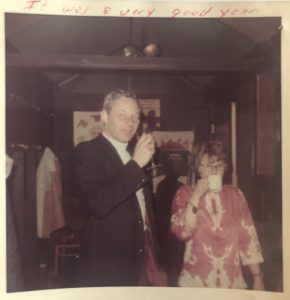
The Wunderbar—one of the first on-mountain après ski bars—was serving martinis and champagne to the Sugarbush crowd, but there was a desire for something more intimate. According to Alex Estin, Peter Estin’s niece, Peter wanted a club where he could hang out with friends away from the general public. Peter and his brother Hans, a former Harvard lacrosse team captain, collaborated with eight of their friends to form a private club just a short ski away from what is now the Spring Fling trail at Lincoln Peak. The club would be modeled after the private European ski clubs and called Ski Club Ten.
There are differing accounts of who, exactly, were the founding ten members of Ski Club Ten. But First Lady Jacqueline Kennedy Onassis’s fashion designer Oleg Cassini recalls the club’s ten founders in his book “In My Own Fashion,” excerpted in a 1988 article in Snow Country magazine: “Together, Igor [Cassini’s brother] and I established a private club at the foot of the mountain. There were ten original incorporators, so we called it Ski Club Ten.” Cassini counts as founders he and his brother Igor, the gossip columnist known as Cholly Knickerbocker; Peter and Hans Estin; Henry J. Heinz II of the Heinz 57 Sauce fortune; Basil Goulandris, the Greek shipping and armaments tycoon; banker George Baker, Jr.; former U.S. Ski Team member Andrew Burden; Neil McConnell, heir to the Avon cosmetics fortune; and Michael Butler, producer of the Broadway musical “Hair.”
In the early days, the club provided ten ski lockers, slopeside parking spaces, and a bar and restaurant on weekends and holidays. Frenchman Olivier Coquelin served as the club’s first manager, setting a precedent for serving gourmet food that lasts to this day. Members go on and on about the quality of the food, from the homemade soups and desserts to the salad bar and hamburgers for the children.
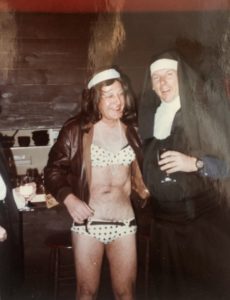
“I remember that Mr. Heinz came one weekend and loved my ochre soup,” recalls Sigi Heslinger, who ran the club for 36 years, from 1969 to 2005. “We had home-made soup every day of the year.” The soup today holds to those same standards, as proven by a bowl of chicken and mushroom soup consumed at a recent Saturday lunch with Mike and Kerry Bisner, members for the last ten years.
Mike recalls coming to the club for lunch as the guest of a friend, and meeting Hans Estin. “Hans asked me where I lived and I replied Manchester-by-the-Sea, in Massachusetts. Hans then asked me what street I lived on. When I replied, he asked me what number. It turned out that he and I were neighbors. Our properties touched, but we had never met. Hans turned around to another member and said ‘He’s in.’” That was the Bisner’s rather informal initiation to the club.
Hans Estin was the unofficial membership director for 50 or so years. And while it was neither spoken nor written, wealth, beauty, and family name appear to have been, and continue to be, influential in the determination of whether someone is membership-worthy. But above all, as Alex Estin remembers, “In Dad’s mind, they had to be fun.”
The club was cherished among members for its lunches and its parties. “New Year’s Eve was big,” recalls Heslinger, “but there was always a dispute about what music would be played.” Calcutta Night, held the night before the annual Ski Club Ten race, was another noteworthy event, where Hans Estin would create ski racing teams and auction them off to the members for betting. While the annual ski race continues, the Calcutta was abandoned years ago. Perhaps the most memorable event in the club’s history is the Crossover Party, where Hans Estin appeared wearing his wife’s bikini.
Estin Park, an enclave of houses on Golf Course Road near the mountain, was the address of several founding members, including Hans and Peter Estin, Michael Butler, and the New York Pops conductor Skitch Henderson. Alex Estin recalls that her uncle originally lived in the “big house,” and Hans in the “smaller house,” until her uncle died unexpectedly in 1963, leaving the big house to Hans. Alex’s stepbrother now owns the smaller house. Cassini recalls in his memoir hosting many weekend guests, including Senator Ted Kennedy, Eunice and Sargent Shriver and Pat Lawford.
Olivier Coquelin ran the club briefly, but left to develop night clubs and discotheques in New York City, including Le Club and Hippopotamus. Coquelin recruited his good friend Henri Borel, another Frenchman, who moved into the basement of the club with his pregnant wife Rosie and his infant daughter Francoise. “They built a small room for me. The furnace, water heater, everything was right there in that room.” Borel managed the club for several years, continuing the French cuisine until Damon and Sara Gadd convinced him to open his own French restaurant, Chez Henri, in Sugarbush Village (see “4 Legendary Ski Bars“). Local photographer and videographer Charlie Brown also served as manager for several years. But Sigi Heslinger was the mainstay for over three decades.
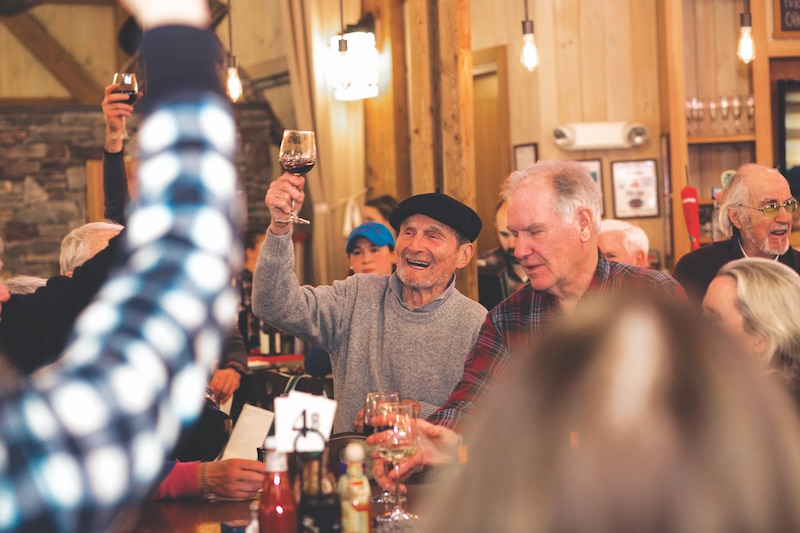
Heslinger ran a tight ship, and insisted on the adults having their own space, separate from the children. Annie Hall, whose father Herbert Tuckerman was a member and friend of Hans Estin, recalls spending time at the club as a teenager, disappointingly relegated to the kids’ room for those under 15. “We would make top-to-bottom runs off the gondola all day long. I would come there to get my hamburger, and then go out skiing again.” She continues, “There was not a lot of heavy skiing in the afternoon, more wine sipping and backgammon. And then that was followed by evenings at Orsini’s, with the whole lot swinging from the chandeliers. . .” That is another story.
Lee Estin Cauro, Peter Estin’s daughter, recalls “a very good looking crowd—men, women and children,” as well as an ambiance infused with songs like “Guantanamera,” and others. Her sister Heidi has vivid memories of the red-checkered tablecloths and the sundeck where members, dressed in their posh ski sweaters, would lounge around getting suntans.
Annie Hall’s daughter Sarah Weigle, and her family moved from Boston to the Mad River Valley and are current members. Weigle and her husband were there recently,
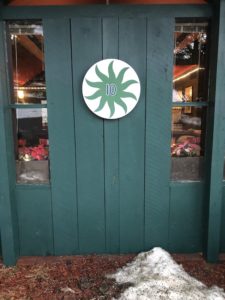
enjoying some lunch and cocktails with friends after a morning of skiing. If Weigle is any indication, along with Sugarbush Wall of Fame inductee Darian Boyle and her mother Florence Boyle, the club’s reputation for beautiful members is very much intact.
The club today is an unremarkable-looking house with hunter green siding and a plain red door displaying a brass sign that reads “Members Only.” The only other clue to the building’s identity is a round, white sign with the number ten floating in the middle of what resembles a green dancing sun with ten rays. The entryway offers a locker for each member, a long coat rack and a wall of hooks for ski helmets. The ten original lockers have been expanded to accommodate the now 85 member families. Several rooms lay beyond the entryway, a main dining room with an open bar and two smaller rooms to the side, one of which is still designated for children. Becoming a member of Ski Club Ten today seems to still be fairly low-key.
The outdoor sun deck is still intact, perhaps more shaded now than it once was. On a recent winter, it hosted a group of about a dozen members who sprinkled the ashes of the club’s beloved leader Hans Estin over the side. Estin died in 2012 after a short illness. His daughter Alex, unaware of this ceremony until very recently, had done the same thing, earlier. “I figured part of him needed to be there, as he spent much of his life there,” she said.
Shortly before his death, Hans Estin passed the baton to long-standing member Clayton Cormier, who, along with his partner Brian Gurney, now oversees club events and membership. As I sat at the bar with Brian, both of us sipping a generous glass of Chardonnay, there was no mention of a plan to honor Ski Club Ten’s 60th anniversary this year.
But the ski season is still young. There is still time to plan a raucous celebration to pay homage to the founders, the fun they had and the bikinis they sometimes wore.
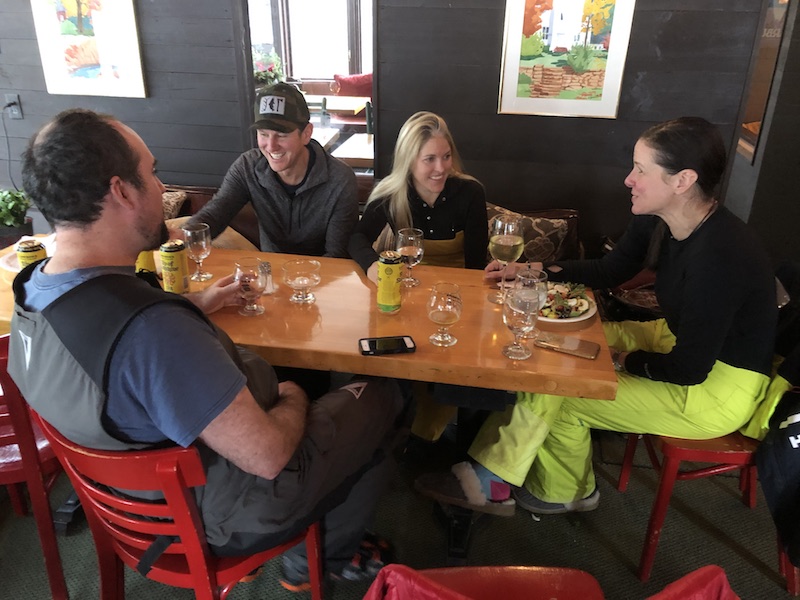
Featured Photo: The slopeside club and its A-list society members helped earn Sugarbush the nickname, ‘Mascara Mountain.’ Photo courtesy Sugarbush Resort.

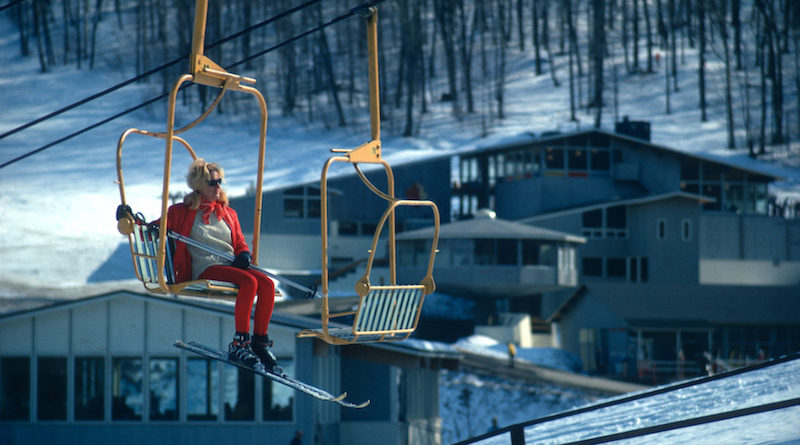
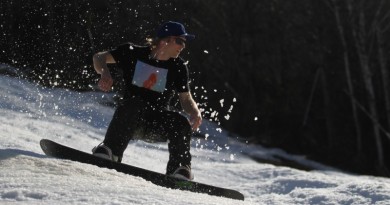
Pingback: Read the Winter Issue! – VT SKI + RIDE